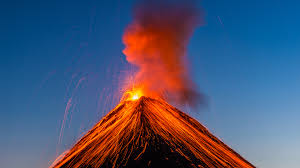Geography Notes On – Volcanic Landforms – For W.B.C.S. Examination.
Volcanic eruptions result in the formation of landforms and here we are going to discuss volcanic landforms.Continue Reading Geography Notes On – Volcanic Landforms – For W.B.C.S. Examination.
Intrusive Forms
- The lava that is discharged during volcanic eruptions on cooling develops into igneous rocks.
- The cooling may take place either on arriving on the surface or also while the lava is still in the crustal portion.
- According to the location of the cooling of the lava, igneous rocks are categorized as plutonic rocks and volcanic rocks.
- The lava that cools inside the crustal portions takes diverse forms. These forms are called intrusive forms.
Batholiths
- Batholiths are the cooled portion of magma chambers.
- It is a large body of magmatic material that cools in the deeper depth of the crust moulds in the form of large domes.
- They appear on the surface only after the denudation processes eliminate the overlying materials.
- These are granitic bodies.
Laccoliths
- These are large dome-shaped intrusive bodies with a level base and linked by a pipe-like channel from below.
- It bears a similarity to the surface volcanic domes of the composite volcano, only these are located at deeper depths.
- It can be considered as the localized source of lava
- The Karnataka plateau is patterned with dome hills of granite rocks.
Lopolith
- When the lava moves upwards, a part of the same tends to move in a horizontal direction wherever it finds a weak plane.
- It can get rested in various forms. If it develops into a saucer shape, concave to the sky body, it is called lopolith.
Phacolith
- It is a wavy mass of intrusive rocks found at the base of synclines or at the top of the anticline in the folded igneous country.
- These wavy materials have a definite outlet to source beneath in the form of magma cavities.
Sills
- The near horizontal bodies of the intrusive igneous rocks are called sill
- The thick horizontal deposits are called sills whereas the thinner ones are called sheets.
Dykes
- Dykes are the most commonly found intrusive forms in the western Maharashtra area.
- When the lava makes its channel through cracks and the fissures, it solidifies almost perpendicular to the ground.
- This gets cooled in the same position to grow a wall-like structure. Such structures are known as dykes.
- These are regarded as the feeders for the eruptions that led to the development of the Deccan traps.
Please subscribe here to get all future updates on this post/page/category/website


 Toll Free 1800 572 9282
Toll Free 1800 572 9282  mailus@wbcsmadeeasy.in
mailus@wbcsmadeeasy.in



















































































































